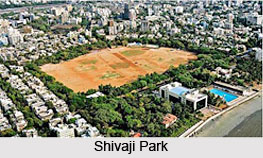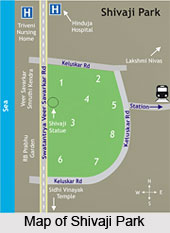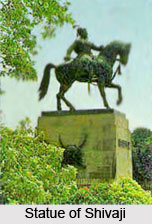 Shivaji Park is a public park situated in Dadar, Mumbai. This park is one of the prime tourist attractions in the metropolitan city of Mumbai.
Shivaji Park is a public park situated in Dadar, Mumbai. This park is one of the prime tourist attractions in the metropolitan city of Mumbai.
Shivaji Park is the largest park in the island city. Like the Azad Maidan and August Kranti Maidan (formerly Gowalia Tank Grounds), Shivaji Park is of historical and cultural value because of the political and social gatherings it has witnessed, both in pre- and post-independence Mumbai.
History of Shivaji Park
Shivaji Park was created in 1925 by the Bombay Municipal Corporation, during the British Colonial Rule. The ground of Shivaji Park was earlier known as the Mahim Park till 1927, when it was named after the legendary 17th century warrior king of the region, Chhatrapati Shivaji at the behest of a municipal councillor, Avantika Gohkale.  The Shivaji Park Gymkhana, then known as the Dadar Hindu Gymkhana, opened its first Tennis court on the grounds in 1927 and inaugurated its pavilion in November 1931.
The Shivaji Park Gymkhana, then known as the Dadar Hindu Gymkhana, opened its first Tennis court on the grounds in 1927 and inaugurated its pavilion in November 1931.
Cricket in Shivaji Park
The 112,937 square metres (27.907 acres) open space in Shivaji Park is renowned as the cradle of Indian cricket. Shivaji Park is renowned as the cradle of Indian cricket. It is home to eight cricket clubs like those of the late Anna Vaidya and Ramakant Acharekar, which have produced several international cricketers for India. Some famous names who have trained here are Sachin Tendulkar, Sunil Gavaskar, Ajit Wadekar, Suhas Gupte, Vijay Manjrekar, Ramakant Desai, Balu Gupte, M.S. Patil, Dilip Sardesai, Ashok Wadekar, Padmakar Shivalkar, Eknath Solkar, Dilip Vengsarkar, Chandrakant Pandit, Lalchand Rajput, Sandeep Patil, Ajit Agarkar, Pravin Amre, Vinod Kambli and Sanjay Manjrekar. It is a feeder park to Ramnarain Ruia College and Poddar College in nearby Matunga.
Structure of Shivaji Park
The open ground or Maidan of Shivaji Park is flanked around its edge by a katta, a simple continuous low kerb edging that forms a makeshift seat, a popular hangout for young and old alike. The paved walkway around this perimeter is crowded with people taking walks. The inner circumference of the park is 1.17 kilometres (0.73 mi). Shivaji Park covers 112,937 square metres (27.907 acres), more than half of which is occupied by 31 tenants, the largest being clubs like the Shivaji Park Gymkhana, and the Bengal Club. The remaining part of the ground and open spaces are available to the public for sports and other activities.
 Other structures dotting the periphery of the grounds include the Samarth Vyayam Mandir (gymnasium), Shivaji Park Nagarik Sangh, a children`s Park, Nana-Nani Park, Scout`s Pavillion, a Ganesh temple and a library. The walkway is lined with huge rain trees. The most prominent entrance to Shivaji Park is the one on the east side, intended only for pedestrians.
Other structures dotting the periphery of the grounds include the Samarth Vyayam Mandir (gymnasium), Shivaji Park Nagarik Sangh, a children`s Park, Nana-Nani Park, Scout`s Pavillion, a Ganesh temple and a library. The walkway is lined with huge rain trees. The most prominent entrance to Shivaji Park is the one on the east side, intended only for pedestrians.
Shivaji Park in Colonial Times
Besides being a venue for gatherings of freedom fighters in British India, after independence in 1947, Shivaji Park was the focal point of the Samyukta Maharashtra Chalval that led to the present Maharashtra state being formed in 1960. During this period, the legendary writer, journalist, playwright, poet and social leader Acharya Prahlad Keshav Atre led this movement, addressing crowds of lakhs at this ground, earning him the title of "Lord of Shivaji Park". Shivaji Park has been integral to the political gatherings of the local party Shiv Sena, and has witnessed numerous other political rallies.



















